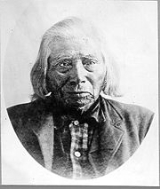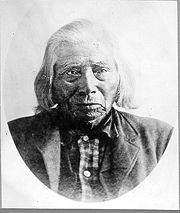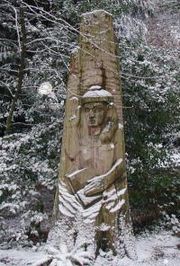
Chief Garry
Encyclopedia

Native Americans in the United States
Native Americans in the United States are the indigenous peoples in North America within the boundaries of the present-day continental United States, parts of Alaska, and the island state of Hawaii. They are composed of numerous, distinct tribes, states, and ethnic groups, many of which survive as...
leader of the Middle Spokane
Spokane (tribe)
The Spokane are a Native American people in the northeastern portion of the U.S. state of Washington. The Spokane Indian Reservation, at , is located in eastern Washington, almost entirely in Stevens County, but includes two very small parcels of land and part of the Spokane River in...
tribe. He also acted as a liaison between white settlers and American Indian tribes in the area which is now eastern Washington state
Washington State
Washington State may refer to:* Washington , often referred to as "Washington state" to differentiate it from Washington, D.C., the capital of the United States* Washington State University, a land-grant college in that state- See also :...
.
Early life and education
The future Spokane Garry (whose original name has been lost to history) was born at the junction of the SpokaneSpokane River
The Spokane River is a tributary of the Columbia River, approximately long, in northern Idaho and eastern Washington in the United States. It drains a low mountainous area east of the Columbia, passing through the city of Spokane, Washington.-Description:...
and the Little Spokane River
Little Spokane River
The Little Spokane River is a major tributary of the Spokane River, approximately 35 mi long, in eastern Washington in the United States. It drains a rural area of forested foothills and a farming valley north of the city of Spokane along the Idaho-Washington border.It rises in southern Pend...
s in or around 1811. He was the son of the tribal chief of the Middle Spokanes
Spokane (tribe)
The Spokane are a Native American people in the northeastern portion of the U.S. state of Washington. The Spokane Indian Reservation, at , is located in eastern Washington, almost entirely in Stevens County, but includes two very small parcels of land and part of the Spokane River in...
, whose name is given by various sources as Illim-Spokanee and Ileeum Spokanee.
When white settlers arrived in the area in 1825, the boy was one of two chosen by the Hudson's Bay Company
Hudson's Bay Company
The Hudson's Bay Company , abbreviated HBC, or "The Bay" is the oldest commercial corporation in North America and one of the oldest in the world. A fur trading business for much of its existence, today Hudson's Bay Company owns and operates retail stores throughout Canada...
to be taught at an Anglican mission school at Fort Garry
Fort Garry
Fort Garry, also known as Upper Fort Garry, was a Hudson's Bay Company trading post at the confluence of the Red and Assiniboine rivers in what is now downtown Winnipeg. It was established in 1822 on or near the site of the North West Company's Fort Gibraltar. Fort Garry was named after Nicholas...
, Rupert's Land
Rupert's Land
Rupert's Land, or Prince Rupert's Land, was a territory in British North America, consisting of the Hudson Bay drainage basin that was nominally owned by the Hudson's Bay Company for 200 years from 1670 to 1870, although numerous aboriginal groups lived in the same territory and disputed the...
(now Winnipeg, Manitoba), which was run by the Missionary Society of the Church of England
Church of England
The Church of England is the officially established Christian church in England and the Mother Church of the worldwide Anglican Communion. The church considers itself within the tradition of Western Christianity and dates its formal establishment principally to the mission to England by St...
. Before he left for Manitoba, he was renamed "Spokane Garry" in honor of his tribe and the deputy governor of the Hudson's Bay Company, Nicholas Garry. His baptism on June 24, 1827 is said to be the first Protestant
Protestantism
Protestantism is one of the three major groupings within Christianity. It is a movement that began in Germany in the early 16th century as a reaction against medieval Roman Catholic doctrines and practices, especially in regards to salvation, justification, and ecclesiology.The doctrines of the...
baptism of a non-white person west of the Rocky Mountains. He was accompanied by another boy known as Kootenais Pelly, who became Garry's closest friend at the school.
The students learned English
English language
English is a West Germanic language that arose in the Anglo-Saxon kingdoms of England and spread into what was to become south-east Scotland under the influence of the Anglian medieval kingdom of Northumbria...
at Fort Garry and were also taught new forms of survival skills. Garry enjoyed learning, but found adjusting to the new life difficult. One story relates that he was once disciplined for disobedience by being whipped with a switch while an older white student held him. Garry became afraid and clenched his teeth only to realize afterwards that he had bitten into the ear of the student holding him. The student waved off the inadvertent attack, leading Garry to realize for the first time that white settlers could be well-intentioned, but also that resistance to authority would likely be futile.
Chief Illim-Spokanee died in late 1828. When spring arrived, Garry and Pelly left the mission school and began the arduous trek back to the Spokane River so that Garry could assume the position of chief of his tribe.
Return to Spokane
Upon their return to Spokane in the fall of 1829, Garry passed on what he had learned at Fort Garry to both his people and to the neighboring peoples of the Columbia Plateau. They returned to the mission the next spring, bringing five other students with them. In 1831 Garry was sent back to the West to notify the Kootenais of Pelly's death, which had taken place at Easter; instead of returning to the Red River afterwards as expected, however, he travelled on to Spokane and never returned.Garry spent much of the next few years preaching his simple Anglican faith in the Columbia Plateau and teaching his people methods of agriculture which he had picked up at the Red River settlement. He found that his new position within the tribal hierarchy created a stronger sense of duty to his people and a need to ensure their peaceful co-existence with white settlers. At this time he married a woman who he renamed Lucy.
In the 1840s the Spokanes were visited by a number of missionaries. Rev. Samuel Parker of the American Board of Commissioners for Foreign Missions was impressed by the piety of the peoples of the region, but other Protestant missionaries thought less highly of the Indians' typical activities, while Catholic missionaries were hostile to both. None were successful in converting the Spokanes to their denominations of Christianity. However, the missionaries' denunciation of Spokane Garry's simple but "primitive" faith was said to have lessened his reputation among the Christians and possibly among his people. His decision to take a second wife was also viewed negatively.
Later years

Whitman massacre
The Whitman massacre was the murder in the Oregon Country on November 29, 1847 of U.S. missionaries Dr. Marcus Whitman and his wife Narcissa Whitman, along with eleven others. They were killed by Cayuse and Umatilla Indians. The incident began the Cayuse War...
of 1847. Garry, a wealthy man by the standards of his tribe, attempted to keep the peace between the two groups.
On October 17, 1853, Garry met with Isaac Stevens
Isaac Stevens
Isaac Ingalls Stevens was the first governor of Washington Territory, a United States Congressman, and a brigadier general in the Union Army during the American Civil War until his death at the Battle of Chantilly...
, the newly appointed Governor of Washington Territory
Washington Territory
The Territory of Washington was an organized incorporated territory of the United States that existed from February 8, 1853, until November 11, 1889, when the final extent of the territory was admitted to the Union as the State of Washington....
. Stevens later professed himself surprised that Garry could speak both English and French fluently, but also wrote that he found himself frustrated by Garry's unwillingness to speak frankly.
Two years later, Stevens summoned the Walla Walla
Walla Walla (tribe)
Walla Walla |Native American]] tribe of the northwestern United States. The reduplication of the word expresses the diminutive form. The name "Walla Walla" is translated several ways but most often as "many waters."...
, Nez Perce, Cayuse
Cayuse
The Cayuse are a Native American tribe in the state of Oregon in the United States. The Cayuse tribe shares a reservation in northeastern Oregon with the Umatilla and the Walla Walla tribes as part of the Confederated Tribes of the Umatilla Indian Reservation...
and Yakama
Yakama
The Confederated Tribes and Bands of the Yakama Nation, or simply Yakama Nation , is a Native American group with nearly 10,000 enrolled members, living in Washington. Their reservation, along the Yakima River, covers an area of approximately 1.2 million acres...
tribes to negotiate a treaty, asking Garry to attend as an observer. The chiefs agreed on a treaty and it seemed there would be peace, but soon the Yakama decided against allowing the whites to take their land and began to prepare for war
Yakima War
The Yakima War was a conflict between the United States and the Yakama, a Sahaptian-speaking people on the Northwest Plateau, then Washington Territory and now the southern interior of Eastern Washington, from 1855 to 1858.- Naming :...
against the United States
United States
The United States of America is a federal constitutional republic comprising fifty states and a federal district...
. They recruited younger members of the Spokanes, but Garry was able to prevent his men from joining the impending battle. He could not stop the war, though, which began on September 23 with the deaths of several miners on the Yakima River
Yakima River
The Yakima River is a tributary of the Columbia River in south central and eastern Washington State, named for the indigenous Yakama people. The length of the river from headwaters to mouth is , with an average drop of .-Course:...
and of A.J. Bolton, the special agent to the Yakamas.
When Stevens heard that war had broken out, he went immediately to the Spokane village and demanded to speak to Garry. The chiefs of the Coeur d'Alene
Coeur d'Alene Tribe
The Coeur d'Alene are a Native American people who lived in villages along the Coeur d'Alene, St. Joe, Clark Fork and Spokane Rivers; as well as sites on the shores of Lake Coeur d'Alene, Lake Pend Oreille and Hayden Lake, in what is now northern Idaho, eastern Washington and western Montana.In...
s, the Spokanes, and Colville
Colville Indian Reservation
The Colville Indian Reservation is an Indian reservation in the north-central part of the U.S. state of Washington, inhabited and managed by the Confederated Tribes of the Colville Reservation, which is recognized by the United States of America as an American Indian Tribe...
s, as well as the leaders of the local French Canadian
French Canadian
French Canadian or Francophone Canadian, , generally refers to the descendents of French colonists who arrived in New France in the 17th and 18th centuries...
community were also in attendance. Stevens promised friendship, but asked the Spokanes to decide immediately between signing a treaty that would hand most of their land over to the whites or declaring war against the United States. He said in part:
Garry made an impassioned speech itemizing all the grievances the Indians had and their unwillingness to give up their ancestral lands for the benefit of the whites. Stevens, finding himself unable to win the argument, retreated, and the Spokanes kept their lands.
In the following years Garry worked to keep the peace between the Spokanes and white settlers. His attempts to negotiate a new treaty with the territorial government were ignored; Stevens instead encouraged the Spokanes to abandon their traditional lands and take up individual ownership under the Indian Homestead Act of 1862
Homestead Act
A homestead act is one of three United States federal laws that gave an applicant freehold title to an area called a "homestead" – typically 160 acres of undeveloped federal land west of the Mississippi River....
. The Spokanes did not receive a reservation under the terms of the treaty they finally signed in 1887.
Later life and legacy
Garry continued teaching well into old age and advising his people until he allegedly gave into gambling and drinking. During his final years he spent much of his time living in his teepee on the Spokane River. He died in 1892.In 1961 Dudley C. Carter
Dudley C. Carter
Dudley C. Carter was a woodcarver from the Pacific Northwest. His works are on display in the U.S. states of Washington, Oregon and California. There are also works of his on display in Japan and Germany....
created a carving of Garry on the site of St. Dunstan's Church of the Highlands
St. Dunstan's Church of the Highlands Parish, Shoreline, Washington
Saint Dunstan's Church of the Highlands Parish is an Episcopal congregation of over 250 people in the Diocese of Olympia. The main church location is located on the city limits between Seattle and Shoreline, Washington. Parishioners primarily come from the northern Seattle, Shoreline, Edmonds, and...
in Shoreline, Washington
Shoreline, Washington
Shoreline is a city in King County, Washington, United States, north of Downtown Seattle bordering the northern Seattle city limits. As of the 2010 census, the population was 53,007, making it the 19th largest city in the state of Washington....
in honor of a biography of Garry written by the then vicar of the congregation.
Sources
- Beck Kehoe, Alice (1981). North American Indians: A Comprehensive Account, Prentice-Hall, ISBN 0136236529.
- Drury, Clifford Merrill (1936). Henry Harmon Spalding, Caxton Printers, Ltd.
- Drury, Clifford Merrill; Walker, Elkanah (1976). Nine Years with the Spokane Indians: The Diary, 1838-1848, of Elkanah Walker, A. H. Clark Co., ISBN 0870621173.
- Drury, Clifford Merrill (2005). A Tepee in His Front Yard: A Biography of H. T. Cowley, Kessinger Publishing, ISBN 1417983809.
- Josephy, Alvin M.; Josephy, Alvin M. Jr. (1997). The Nez Perce Indians and the Opening of the Northwest, Houghton Mifflin Books, ISBN 0395850118.

